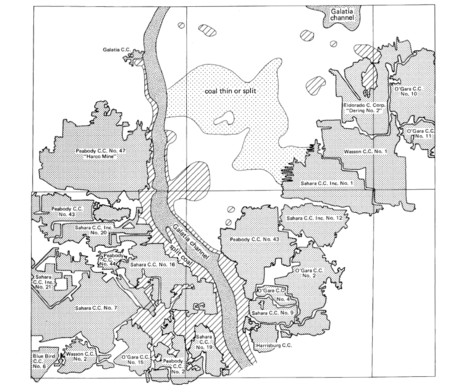Circular 530
Geologic Disturbances in Illinois Coal Seams
W. John Nelson
Abstract
Mining problems result when coal seams are broken, distorted, or intruded upon by geologic features such as:
- Channels - (Pleistoceneor Pennsylvanian riverbeds) filled with rock or unconsolidated deposits that cut into coal seams, weaken roof strata, and store groundwater. Near some channels, coal may be thick, low in sulfur and high in ash content-and split.
- Splits - (overbank or floodwater deposits in peat swamps) that are layers of noncoal materials divide coal seams horizontally; they either make it impossible to mine the seam as one unit, or increase the product's waste rock and ash content.
- Rolls - (small, infilled channels) or lenses of roof rock that protrude into the top of coal seams, producing steep dips or abruptly thin seams as well as poor roof conditions.
- Clay dikes - (vertical, clay-filled cracks in peat) that in trude from overlying rock into coal seams, increase the product's waste rock and ash content, and cause unstable roof conditions.
- Igneous dikes - (magma-filled fractures in coal seams) intrude steep walls of rock into coal seams; they may be surrounded by coal coked from the heat of the magma.
- Coal balls - (mineralized peat)-so hard and dense compared to the surrounding coal that massive deposits damage mining equipment and sometimes halt operations.
Other disturbances include limestone bosses, white top, joints in coal and roof rock, and deformation by glacial ice, concretions, and fossil tree stumps. Most can be recognized during exploratory drilling and by use of seismic exploration or surveying. Some features, such as channels and splits, are extensive enough t o be mapped ahead of mining; others are localized and unpredictable.
Introduction
Coal miners always face obstacles in their struggle to win coal from the earth. Coal beds-normally thick, level, and continuous-sometimes pitch sharply up or down, split into layers too thin to follow, fill with veins of clay or masses of stone, or end abruptly against solid rock. Unexpectedly, the roof may become almost impossible to support.Volumes of water or deadly gases may rush in a t the face.The risks and the costs, especially in lives, are great for miners, mine owners, and mining communities.
Locating, predicting, and controlling geologic hazards in coal seams depend upon knowing how they formed: What combination of climate, landscape, and vegetation produced coal seams and the disturbances associated with them, such as channels, splits, rolls, limestone bosses, clay and igneous dikes, and coal balls?Another publication discusses faults: Illinois State Geological Survey Circular 523, Faults and Their Effect on Coal Mining in lllinois, W. J . Nelson, 1981
According to geologists, most of these disturbances developed while the coal itself was forming-during the Pennsylvanian Period, approximately 315 to 280 million years ago. A t this time, coal beds and other sedimentary rocks began as layers of peat, mud, silt, and sand deposited in rivers, lakes, swamps, deltas, tidal flats, and oceans. The original sediments were often laid down irregularly. Peat beds were frequently scoured and ripped up when rivers changed courses or overflowed banks; or they were torn apart when underlying sediments slumped in landslides. Later, the coal-to-be was squeezed and contorted as it was buried beneath thousands of feet of sediment; and occasionally, coal seams were pierced and baked by molten magma. More recently, during the Pleistocene Epoch, enormous masses of glacial ice deformed coal beds near the surface, while rivers of glacial meltwater washed away other coal seams.
To describe the problems, then to identify the causes of these disturbances in Illinois coal seams required extensive mapping of both surface and underground mines. Field investigation for this project covered every active mine in Illinois. Other sources of information included the Geological Survey's large collection of notes, photos, sketches, and maps of active and abandoned mines as well as drillers' logs, geophysical logs, and core descriptions.
Since both miners and geologists are especially concerned with the effects of geologic disturbances on Illinois coal mining, both points of view are presented in the following report.
| Geologic Disturbances in Illinois Coal Seams | ||||||||||
|---|---|---|---|---|---|---|---|---|---|---|
| Channels | Split Coal | Rolls | Limestone Bosses | Clay Dikes | White Top | Igneous Dikes | Joints | Coal Balls | Miscellaneous Disturbances | Acknowledgments |


